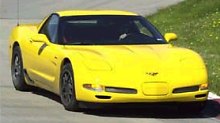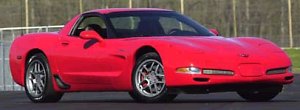 Before
the arrival of Dodge Viper, Corvette used to be the dream of every
American
car lovers. The first Corvette appeared in 1955. In then it was powered
by an underpowered inline six cylinder engine. The second generation,
nickname
"Sting Ray", appeared in 1963. High output "big block" V8, a much
improved
chassis and an aggressive styling brought it true success and
reputation
as the best sports car in the USA. In mid-70's we saw the third
genration
hit by oil crisis and lost a hundred horsepowers. Other areas did not
improved
much from the Sting Ray too. The forth generation in 1984 received a
fuel-injected
small block capable of 230hp, a much modernised appearance and chassis,
all double wishbones suspensions, also the advanced ABS. Near the end
of
its life, C4's pushrod V8 was upgraded to the 300hp LT1, and at last
the
330hp LT4, but the basic design was never changed. Before
the arrival of Dodge Viper, Corvette used to be the dream of every
American
car lovers. The first Corvette appeared in 1955. In then it was powered
by an underpowered inline six cylinder engine. The second generation,
nickname
"Sting Ray", appeared in 1963. High output "big block" V8, a much
improved
chassis and an aggressive styling brought it true success and
reputation
as the best sports car in the USA. In mid-70's we saw the third
genration
hit by oil crisis and lost a hundred horsepowers. Other areas did not
improved
much from the Sting Ray too. The forth generation in 1984 received a
fuel-injected
small block capable of 230hp, a much modernised appearance and chassis,
all double wishbones suspensions, also the advanced ABS. Near the end
of
its life, C4's pushrod V8 was upgraded to the 300hp LT1, and at last
the
330hp LT4, but the basic design was never changed.
Nearly all Corvette used to be praised of powerful engine and electric performance, but at the same time was criticised as lack of handling goodness and ride comfort. As time went by, American get used to these characters and decribed them as "American spirit". They didn't care a Porsche 944S outhandle their dream car, just emphasis the time measured by the stop watch. The situation has changed, if not revoluted, since the arrival of the C5. Like the classic Sting Ray, the C5 was developed started from a clean sheet. GM's engineers went to the drawing board to create a completely new chassis, which is claimed to be 4.5 times stiffer than the poor C4. It's a back bone chassis, inside the transmission tunel there is a 5-in diameter torque tube rigidly connected between the engine and the rear-mounted transaxle. Chassis rails are made by hydroform process, a technique using liquid pressure to shape a metal tube with the advantage of uniform thickness in everywhere, thus improve rigidity / weight ratio. The stiffer chassis allows the suspensions setting to be softened, thus enhance ride comfort yet still make the car handles more stable than its predecessor. By using aluminium suspension arms, unsprung weight is vastly reduced thus once again improve ride quality. It also helps to cut weight. When talking about weight saving, the all-new LS1 engine must be mentioned. Strangely, GM still develop a new pushrod engine in the late 90's, and even use it to power its flagship sports car. Some people said the development cost of a new pushrod V8 is just a fraction of a new high-output multi-valve dohc V8, while Cadillac's Northstar is not supposed to be able to tune to about 350hp and 350lbft. Another opinion said a 5.7 litres pushrod V8 can maintain the torque-biased characteristic that Corvette lovers used to admire. The LS1 engine features aluminium head and block, the latter a first for Corvette and itself alone saves 40 kg. Lighter engine also improved weight distribution to 51 : 49 between front and rear, nearly perfect !
Weight saving also extend to the roof, which has a magnessium frame. Overall speaking, the C5 is 36kg lighter, yet the chassis is a lot stiffer, yet its width and wheelbase exceeds C4 by 25mm and 210mm repectively in order to improve handling. Looking from outside, the C5 is just an evolution from C4. It doesn't imply the revolution under the cost-saving composite body, but it also preserves the shape that many Corvette lovers want. One thing they may not notice is, the coefficient of drag is now lowered to a remarkable 0.29. Open the door, you'll find the door sill is lower. The seat might not be very supportive for such a fast car, but there is generous of foot room compare with TVR, thanks to the rear-mounted gearbox. Fire the engine and start going, the V8 has mountain of torque to soar your neck. Its noise is not in Ferrari's or Porsche's quality, probably because of the lack of rpm. Very fast, the C5 push all the way without sweat, reaching 60mph in 5.3sec, passing the ton at 11.5sec. It tops slightly above 170mph. Undoubtedly, handling and ride has been improved very much. In the past, every European car magazine criticised the C4 in this aspect without mercy, now their words become much more careful. "Reasonably good" seems to be the best phrase to describe the C5's handling and ride, as it is still not up to the level of the European bests, say, Porsche Boxster, Lotus Esprit and TVR Cerbera Speed Six. I personally like to mention the Cerbera Speed Six as its opponent. Similarly powerful, similarly priced and similar composite body make them logical rivals, just separated by the Atlantic ocean. Facing the TVR, Corvette's steering seems quite lack of the final feeling. It corners without the adjustability and compliance as the Cerbera, goes in straight line slower than the British lightweight too. Speed Six takes just 4.5sec and 10.2sec to 60mph and 100mph respectively, even faster than the electric Corvette. Its 24 valves straight six is high-revving yet smooth, deliver excitement that the torque-biased pushrod V8 cannot hope for. However, the
Corvette is
still the best choice in its price range for most people. It has the
advanced
equipments (ABS, Traction control, Stability control) and luxury items
that the raw TVR never offer. It is an everyday car suitable to go to
work,
to the beach and also to have an exciting weekend drive. Moreover,
Corvette
is available in convertible version too. |
| The above report was last updated on 18 Feb 99. All Rights Reserved. |
 The new
V8 displaced 5665c.c.,
just dozens c.c. less than its predecessor. In-plane pushrod valve gear
reduce friction and make it more compact. Electronic throttle enables a
more effective traction control to be equipped, and even the optional
"Active
Handling Chassis Control System", a kind of electronic stability
control.
An easier visible new feature is a thermoplastic intake manifold, which
saves weight.
The new
V8 displaced 5665c.c.,
just dozens c.c. less than its predecessor. In-plane pushrod valve gear
reduce friction and make it more compact. Electronic throttle enables a
more effective traction control to be equipped, and even the optional
"Active
Handling Chassis Control System", a kind of electronic stability
control.
An easier visible new feature is a thermoplastic intake manifold, which
saves weight.  Z06, what
a cool name. Chevrolet Corvette used this name for the first time in
1963,
representing a hotter, race-ready Sting Ray. Today, the Corvette Z06 is
reborn in a more user-friendly form, not as racy as Mustang Cobra R but
it is easily the hottest Corvette since the ZR1. Compare with the
standard
Corvette, it gets 35 extra horsepower yet weighs less, further with
improved
suspensions, tyres etc. to complete an exciting package.
Z06, what
a cool name. Chevrolet Corvette used this name for the first time in
1963,
representing a hotter, race-ready Sting Ray. Today, the Corvette Z06 is
reborn in a more user-friendly form, not as racy as Mustang Cobra R but
it is easily the hottest Corvette since the ZR1. Compare with the
standard
Corvette, it gets 35 extra horsepower yet weighs less, further with
improved
suspensions, tyres etc. to complete an exciting package.
 Despite
of more power and
less weight, Chevy still revised the gear ratios of the Getrag
6-speeder
to enhance acceleration. Chevrolet’s official press release said the
car
is capable to reach 60 mph in 4 seconds flat, but their figures are
usually
too optimistic. Motor Trend timed 4.53 seconds, which is nearly half a
second quicker than the standard Corvette they timed. Launch in a
normal
grip road, I believe 4.6 seconds is more realistic. 0-100 mph just
marginally
fails to qualify for the "Sub-10-sec Club".
Despite
of more power and
less weight, Chevy still revised the gear ratios of the Getrag
6-speeder
to enhance acceleration. Chevrolet’s official press release said the
car
is capable to reach 60 mph in 4 seconds flat, but their figures are
usually
too optimistic. Motor Trend timed 4.53 seconds, which is nearly half a
second quicker than the standard Corvette they timed. Launch in a
normal
grip road, I believe 4.6 seconds is more realistic. 0-100 mph just
marginally
fails to qualify for the "Sub-10-sec Club".